Thiele TWN 0861 User manual

B09343-A 1 / 3 EN-200916
Mounting Instructions
Original in compliance with 2006/42/EG
Chain Coupling Shackles
Grade 8
TWN 0861
TWN 0862
TWN 0897
Manufacturer:
THIELE GmbH & Co. KG
Tel: +49 (0) 2371 / 947 - 0
58640 Iserlohn
www.thiele.de
1 Description and Intended Use
THIELE-Chain coupling shackles are intended as end fittings of chain sling
assemblies. The chain strands are to be fitted directly to the clevis.
Shackles of TWN 0861 are intended to be mounted once to be left on the
load permanently.
Shackles must exclusively be used
within the limits of their permissible Working Load Limit,
within the temperature limits prescribed,
with their original bolts and dowel pins of appropriate size.
THIELE-Chain coupling shackles meet EG Machinery Directive 2006/42/EG
requirements and feature a safety factor of at least 4 based on Working
Load Limit (WLL).
Mostly they are certified by the german Employers’ Liability Insurance Asso-
ciation and signed by H4 symbol.
Generally they are signed with the associated chain size and grade, manu-
facturers mark and traceability code.
Shackles must only be used with a single loaded chain leg.
THIELE-shackles are designed to withstand 20,000 dynamic load changes
under maximum load conditions. In the event of higher loads (e.g. multi-
shift/automatic operation, magnetic spreaders) the WLL must be reduced.
Generally they are not intended to be used for passenger transportation.
An alternating use for lifting and lashing is not allowed.
If shackles are employed for lashing applications the maximum lashing
capacity results from a doubling the Working Load Limit.
2 Safety Notes
Risk of Injury!
Never walk or stay under lifted
loads!
Make sure to use hoisting/
attachment means free from de-
fects.
Operators, fitters, and maintenance personnel must in particular observe
the Operating Instructions also from the used sling chain assemblies,
documentations DGUV V 1, DGUV R 100-500 Chapter 2.8, DGUV I 209-
013 and DGUV I 209-021 issued by the German Employers’ Liability In-
surance Association, as well as standard specifications DIN EN 818-6,
and DIN EN 13889 Appendix A.
Outside the Federal Republic of Germany the specific provisions issued
locally in the country where the items are used must also be observed.
The directions given in these Mounting Instructions and specified docu-
mentations relating to safety, assembly, operation, inspection, and
maintenance must be made available to the respective persons.
Make sure these Mounting Instructions are available in a place near the
product during the time the equipment is used.
Please contact the manufacturer if replacements are needed.
When performing work make sure to wear your personal protective
equipment!
Improper assembly and use may cause personal injury and/or
damage to property.
Assembly and removal as well as inspection and maintenance must
exclusively be carried out by skilled and authorized persons.
Structural changes are impermissible (e.g. welding, bending).
Never attempt to make the shackle opening smaller by bending or weld-
ing in intermediate elements.
Visually inspect shackles and equipment prior to each use.
Usage without safety devices (nuts, dowels pins) is not permitted.
Never put to use worn-out, bent or damaged shackles.
Never expose shackles to loads exceeding the specified Working Load
Limits.
Do not use force when mounting/positioning shackles.
Make sure the load can take the forces to be applied without suffering
deformation.
Lateral loads bending the shackles are not permissible. Shackles must
be capable of aligning themselves in loading direction.
Do not start lifting before you have made sure the load has been correct-
ly attached.
Make sure no one including you (operator) is in the way of the moving
load (hazard area).
During lifting/hoisting make sure your hands or other body parts do not
come into contact with hoisting means. Only remove hoisting means
manually (use your hands).
Avoid impacts, e.g. due to abruptly lifting loads with hoisting means in
slack condition.
Applications where the bolt may become threaded out, e.g. by a rope or
load, shall be avoided. If such applications can not be avoided bolts with
safety pins shall be used.
If shackles are expected to perform under continuous service conditions
(multi-shift, automatic operations or the like) contact the manufacturer
first to reduce the WLL as necessary.
Avoid shackles to get caught under the load.
THIELE will not be responsible for damage caused through non-
observance of the instructions, rules, standards and notes indicated!
In the event of doubts about the use, inspection, maintenance or similar
things contact your safety officer or the manufacturer.
3 Commissioning
Prior to using the components for the first time make sure that
the shackles comply with the order and have not been damaged,
test certificate, statement of compliance and Mounting Instructions are at
hand,
markings correspond with what is specified in the documentation,
the documentation is safely kept in an orderly manner.
Dispose of the packing in an environmentally compatible way according to
local rules.

B09343-A 2 / 3 EN-200916
4 Technical Data
TWN 0861 Special Chain Coupling Shackles, Grade 8
Size
Article-no.
Working
Load Limit
[t]
Weight
[kg]
Spare sets
Spare sets
Dimensions [mm]
Load pin +
Dowel pin
Bolt + Dowel pin
E
D
C
F
B1
B2
10-8
F30601
3,15
0,61
F48355
F48036
64
16
32
36
21
47
13-8
F30611
5,3
1,24
F48358
F48039
82,5
20
40
49
27
61
16-8
F30621
8,0
2,1
F48361
F48042
99
24
48
56
33
75
18-8
F30631
10
3,93
F48364
F48045
115
30
60
63
42
100
TWN 0862 Chain Coupling Shackles, Grade 8
Size
Article-no.
Working
Load Limit
[t]
Weight
[kg]
Spare sets
Spare sets
Dimensions [mm]
Load pin +
Dowel pin
Bolt + Nut +
Cotter pin
E
D
C
F
B1
B2
10-8
F30600
3,15
0,67
F48355
F30451
64
16
32
36
21
47
13-8
F30610
5,3
1,37
F48358
F30461
82,5
20
40
49
27
61
16-8
F30620
8,0
2,28
F48361
F30471
99
24
48
56
33
75
18-8
F30630
10
4,37
F48364
F30481
115
30
60
63
42
100
TWN 0897 Special Coupling Shackles, Grade 8
Size
Article-no.
Working
Load Limit
[t]
Weight
[kg]
Spare sets
Spare sets
Dimensions [mm]
Load pin +
Dowel pin
Bolt + Nut +
Cotter pin
E
D
C
F
B1
B2
6-8
F30586
1,12
0,47
F48694
F30461
70
20
39
46
35
65
8-8
F30596
2,0
0,54
F48352
F30461
70
20
40
46
35
65

B09343-A 3 / 3 EN-200916
5 Assembly and Removal
Allways assemble/remove shackles or parts in load-free condition.
To prevent unilateral loads and misalignment spacers may be arranged to
center the load application point on the bolt.
Disassemble the parts in reverse order.
Use a suitable drift punch to drive the dowel pins out.
Suitable drift punches are available by Article No. Z03303.
Dowel pins and cotter pins must only be installed once.
Assembly of Clevis-type Hook System:
1.Remove load bolt and dowel pin.
2.Place end of chain leg between the lateral
clevis elements.
3.Push pin from the side fully into the clevis
and through the last chain link of the leg.
4.Drive dowel pin fully in (must not project) to
secure the pin. The slot must face away
from the pin.
5.Check the chain can move freely.
Bolt Assembly TWN 0861
1.Move the bolt through both holes in the
shackle ends and see to it that the two
grooves in the bolt are positioned con-
centrically with the dowel pin holes in
the shackle body.
2.Insert the dowel pins. Make sure the slot
faces away from the bolt towards the
shackle bow.
Bolt Assembly TWN 0862 and TWN 0897
1.Fully insert the bolt through both
shackle boreholes.
2.Retain the bolt with a suitable nut
and tighten the nut so as to be hand-
tight using an appropriate tool.
Make sure bolt and nut are evenly
seated against the shackle body.
3.Finally, insert the cotter pin in the re-
spective hole in the bolt to secure the
connection.
6 Conditions of Use
6.1 Normal Use
Shackles must not be exposed to bending loads; make sure excentric loads
are avoided.
Shackles must be able to move freely. Supporting of shackles on other parts
is not permitted.
Take care that
incorrect arrangements are avoided, e.g. excentric loads,
damage of lifting or lashing accessories, e.g. by sharp edges, is not possi-
ble,
the shackles can be reached easily for fitting/unhinging lifting or lashing
accessories.
The degree of danger when used in offshore applications, the lifting of per-
sons or hazardous loads, such as for example liquid metal, or similar risk
potentials have to be assessed by a competent person in the form of a risk
analysis. Any additional rules and directives must be followed in this case.
falsch
richtig
richtig
6.2 Influence of Temperature
Using shackles at elevated temperatures will cause the Working Load Limit to
be reduced as indicated below.
Grade
Temperature range
Remaining WLL
8
-40 °C ≤200 °C
100 %
200 °C ≤300 °C
90 %
300 °C ≤400 °C
75 %
10/XL
-30 °C ≤200 °C
100 %
200 °C ≤300 °C
90 %
300 °C ≤380 °C
60 %
If shackles have been exposed to temperatures exceeding the maximum
values specified they must no longer be used.
6.3 Environmental Influence
Shackles must not be used in environments where acids, aggressive or
corrosive chemicals or their fumes are present.
Hot-dip galvanizing or a galvanic treatment is prohibited as well.
7 Spare Parts
Only use original spare parts. See chapterl 4.
8 Inspections, Maintenance, Disposal
Inspections and maintenance must be arranged for by the Owner!
Inspection intervals shall be determined by the Owner!
Inspections must be carried out and documented by competent persons
regularly but at least once a year, or more frequently if the shackles are in
heavy-duty service. After three years at the latest they must additionally be
examined for cracks. A load test shall never be considered a substitute for
this examination.
The results of the inspection shall be entered into a register (DGUV I 209-062
or DGUV I 209-063) to be prepared at first use. The register will show charac-
teristic data as well as identity details.
Immediately stop using shackles that show the following defects:
missing or illegible identification/marking,
deformation, elongation or fractures of shackles or components,
cuts, notches, cracks, incipient cracks, pinching,
damaged threads,
shackles heated beyond permissible limits,
severe corrosion,
impaired or missing safety systems,
wear in excess of 10 %, e.g. in the receiving area of the pin diameter,
Inspection Service
THIELE offers inspection, maintenance and repair services by trained and
competent personnel.
Maintenance and Repair
Minor notches and cracks may be eliminated by careful grinding observing
the maximum cross section reduction requirement of 10 % and avoid making
more severe cuts or scores.
All maintenance and repair activities are to be documented.
Disposal
All components and accessories of steel taken out of service are to be
scrapped in line with local regulations and provisions.
9 Storage
Shackles should be stored in dry locations at temperatures ranging
between 0 °C and +40 °C.
10 Impressum
THIELE GmbH & Co. KG, Werkstraße 3, 58640 Iserlohn, germany
Tel.: +49(0)2371/947-0 // Email: info@thiele.de
© THIELE GmbH & Co. KG, 2015. All rights reserved.
‘#’ Changes to previous edition.
1.
2.
3.
This manual suits for next models
2
Other Thiele Industrial Equipment manuals
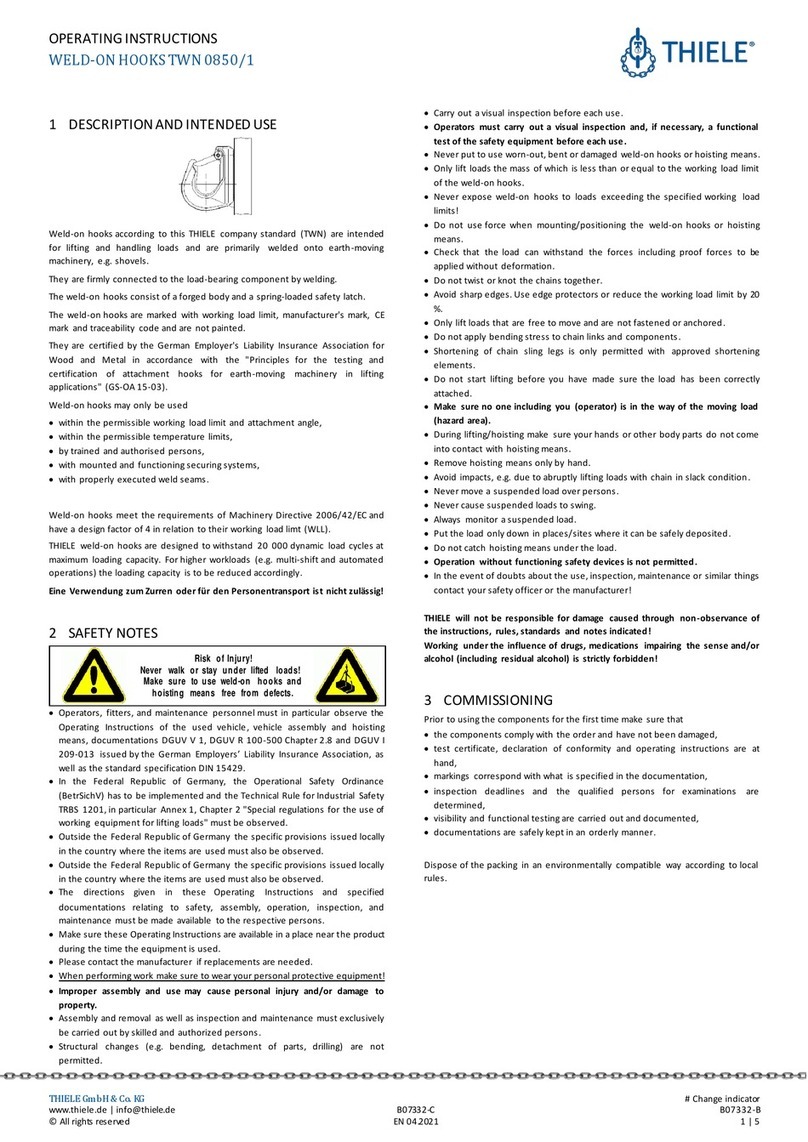
Thiele
Thiele TWN 0850/1 User manual
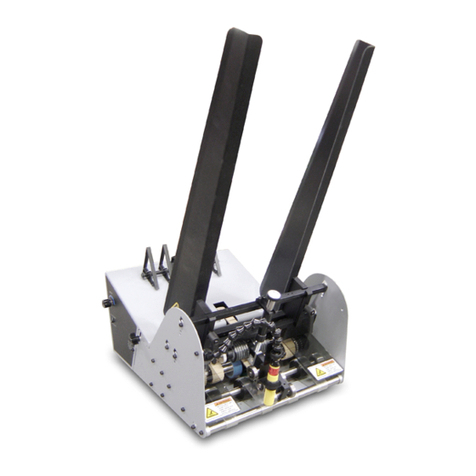
Thiele
Thiele Streamfeeder Value Series User manual
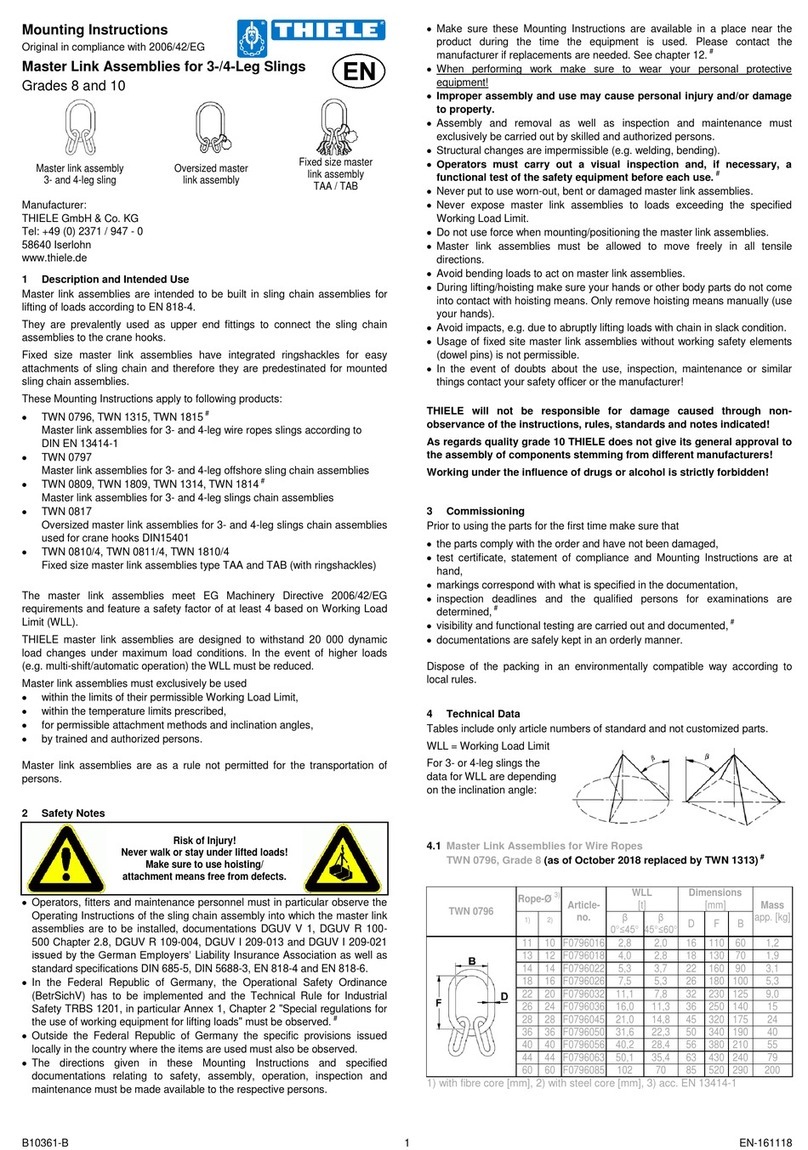
Thiele
Thiele TWN 0796 User manual
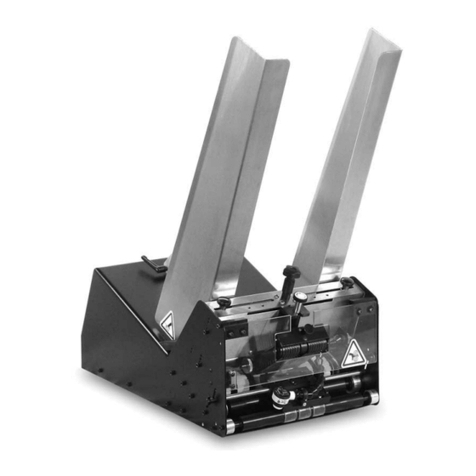
Thiele
Thiele Streamfeeder Reliant 3700 User manual
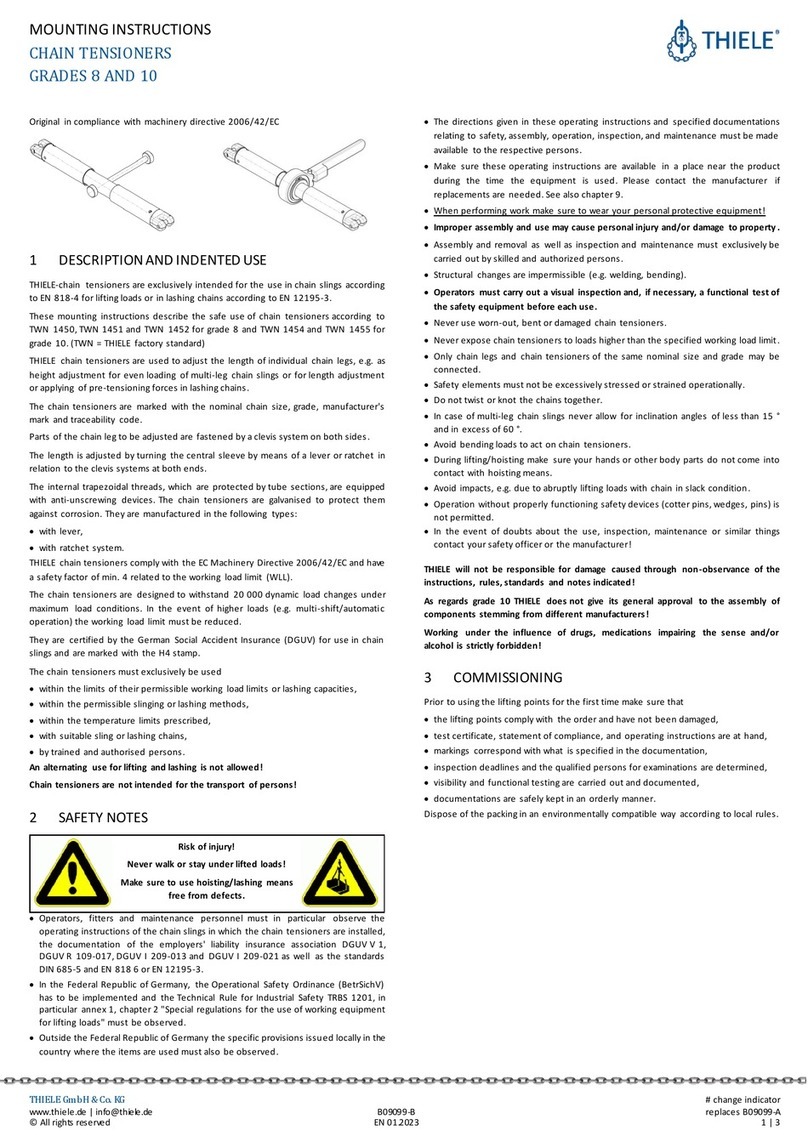
Thiele
Thiele TWN 1450 User manual

Thiele
Thiele TWN 1472 User manual

Thiele
Thiele TWN 0812 User manual

Thiele
Thiele Streamfeeder Reliant 3700 User manual
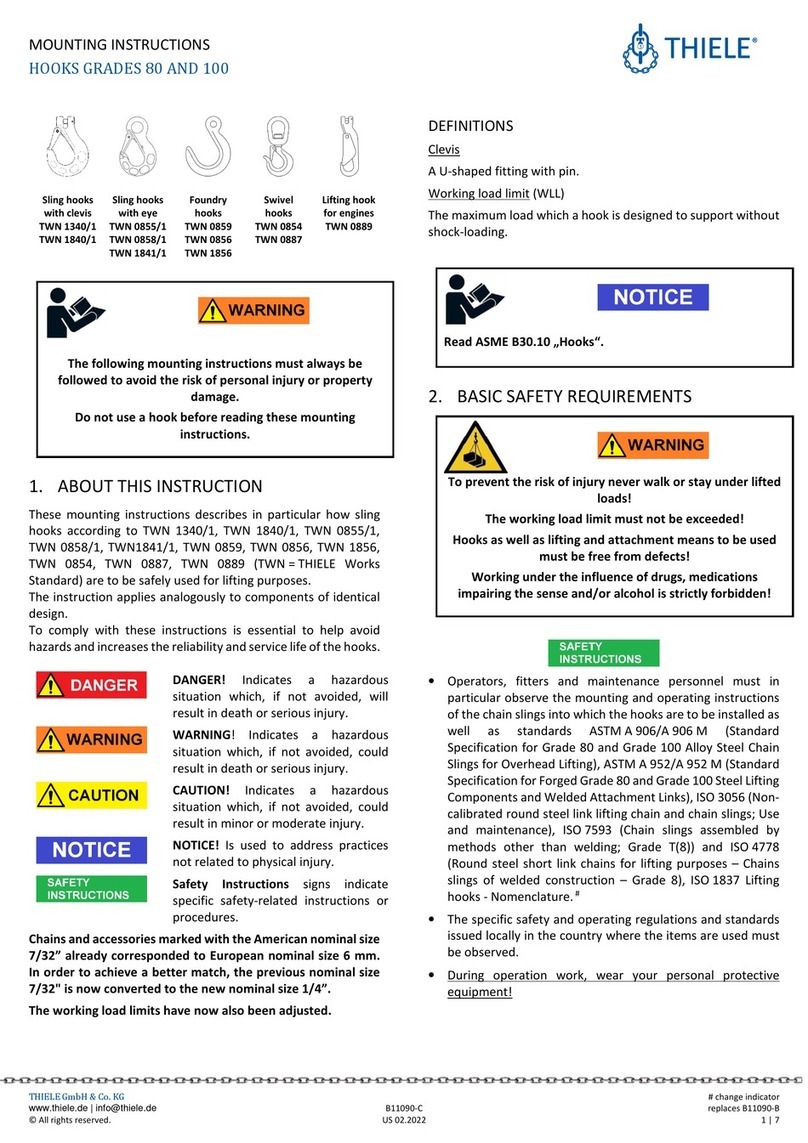
Thiele
Thiele TWN 1340/1 User manual
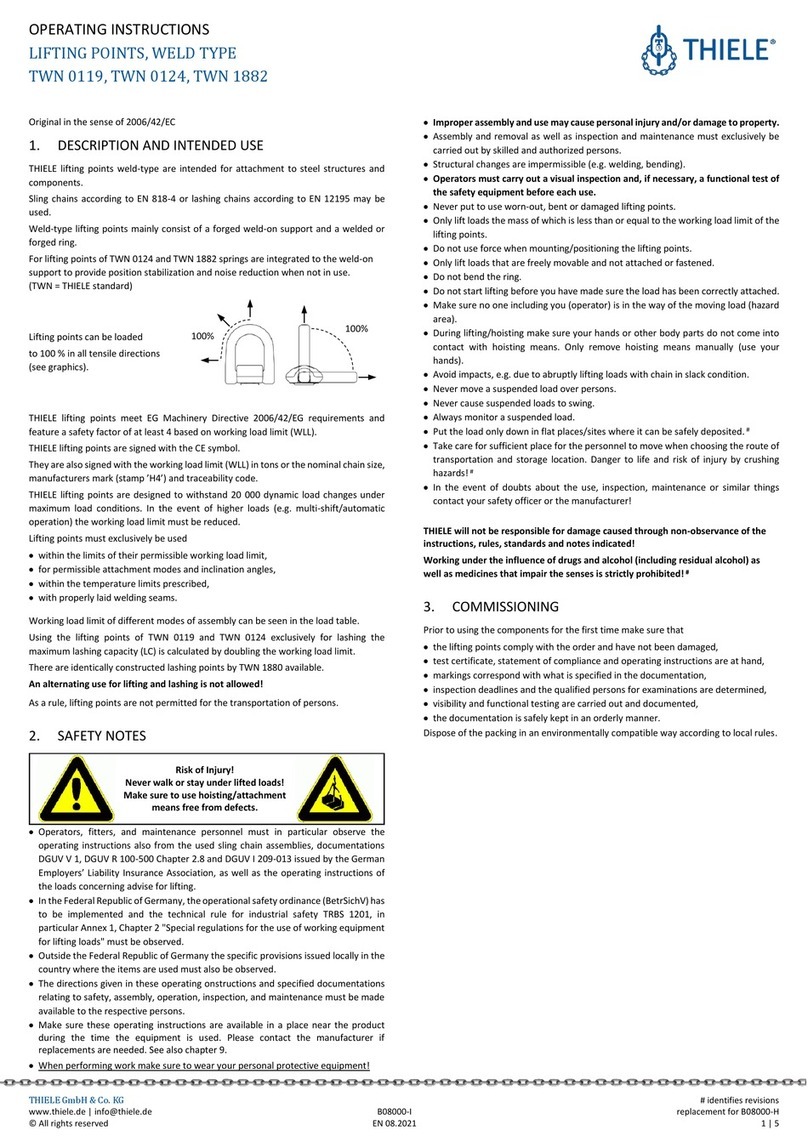
Thiele
Thiele TWN 0119 User manual


















